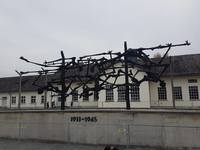Photo. Dachau concentration camp, Konzentrationslager (KZ) Dachau, the first Nazi concentration camp outside Munich in Germany. Dachau served as a prototype and model for the other Nazi concentration camps that followed. © Travel Explorations.
Dachau keeps a dark and significant place in history as a symbol of the horrors of the Holocaust and Nazi brutality. The purpose was to hold political prisoners, but it developed into much more than that. The camp is located on the grounds of an abandoned munitions factory northeast of the medieval town of Dachau, about 16 km (10 mi) northwest of Munich in the state of Bavaria, in southern Germany. It is very difficult for an outsider to imagine how little value human life was regarded in this camp. It incredible hard for me to get insight in how the SS developed this notorious Nazi concentration camp, who they imprisoned, and how the inmates lived. All their intention was to take away human dignity or personal identity.
As mentioned, Dachau opened in 1933, shortly after Adolf Hitler (1889-1945) became chancellor of Germany. In 1965, a memorial site was etablished here. Today, it`s possible to visit some of the camp's historical buildings. You can also get access to a library and special exhibitions containing materials related to Dachau's history.
The gate to the main entrance had the words "Arbeit Macht Frei" ("Work Makes You Free") at the top.The first camp was a re-use of an old munitions factory from the first world war that existed on the site. The camp completed in 1938 was designed for 6,000 prisoners but often held much more. The camp was surrounded by electrified fences and watchtowers.
Watch photos from Dachau on our Facebook page Travel Explorations.
In 1942, the crematorium area was constructed next to the main camp. It included the old crematorium and the new crematorium (Barrack X) with a gas chamber. While Dachau did have a gas chamber, it is debated whether it was used for mass executions. Instead, prisoners underwent "selection"; those who were judged too sick or weak to continue working were sent to the Hartheim "euthanasia" killing center near Linz, Austria. Several thousand Dachau prisoners were murdered at Hartheim. Further, the SS used the firing range and the gallows in the crematoria area as killing sites for prisoners (source: Encyclopedia).
In Dachau, as in other Nazi camps, German physicians performed medical experiments on prisoners, including high-altitude experiments using a decompression chamber, malaria and tuberculosis experiments, hypothermia experiments, and experiments testing new medications. Prisoners were also forced to test methods of making seawater potable and of halting excessive bleeding. Hundreds of prisoners died or were permanently disabled as a result of these experiments. As Allied forces advanced into Germany in 1945, they liberated Dachau on 29th April 1945. The discovery of the camp and the horrific conditions shocked the world and served as evidence of Nazi atrocities.
Visiting Dachau was for me a difficult experience. How should I react? How would it affect me? I felt speakless. You don`t find words for this. Gasping after air, trembling, sweating, and crying are some the the reaction visitors get. One thing is reading about the concentration camp, another is to exploring the site yourself. It`s impossible to be untouched walking around at this and thinking of all the bad things that have happened. Even how worse it has been, I had to protect myself for taking it too hard emotionally. For a long time after I left the camp, I was thinking of what was going on here in the past.
The wide extend of cruelty make the horrors of Dachau deeply shocking. This has haunted me for a long time already before I visited this place, as I struggle to understand how humans can commit such atrocities against one another. The psychological impact of Dachau’s environment on its prisoners was profound. The Nazis systematically dehumanized prisoners, stripping them of their identities, dignity, and humanity. This was exemplified through the tattooing of numbers, forced labor, and the denial of basic human rights.
Nazi concentration camp badges i Dachau, primarily triangles, were part of the system of identification in Nazi camps. Sculpture represents here three links in a chain. It symbolize the unity between the prisoners. Red triangles were worn by the Communists, Social Democrats and other political prisoners and blue by the foreign workers, mostly Poles, who were brought to the Dachau camp. The Jews always wore two triangles with a yellow triangle on top of another color, usually red which signified a political prisoner. The following description is based on the badge coding system used before and during the early stages of the war in the Dachau concentration camp, which had one of the more elaborate coding systems. Single triangles (source: Wikipedia).
Today, the Dachau concentration camp serves as a memorial and museum to remember the victims of the Holocaust and educate visitors about the atrocities committed there. The site includes exhibitions, memorials, and preserved buildings from the camp.
Dachau's history reminded me of the enormous Nazi cruelty. It`s hard to think of all the innocent people who suffered so terrible during the Holocaust. For me it was a site for remembrance and reflection. My visit here gave me a strong lessons of history for life. Hopefully for other visitors too. Must not be forgotten. That`s the only way we can avoid this to happening again.
Stein Morten Lund, 2nd November 2018
Additional information
Read more about Dachau on History.com.
Information about Nazi concentration camps (Birkbeck, University of London).
Between 1933 and 1945, Nazi Germany and its allies established more than 44,000 camps and other incarceration sites (including ghettos). The perpetrators used these sites for a range of purposes, including forced labor, detention of people thought to be enemies of the state, and for mass murder. The Holocaust was the systematic, state-sponsored persecution and murder of six million Jews by the Nazi regime and its allies and collaborators. Learn more about the history on United States Holocaust Memorial Museum.












